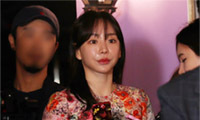A Gauguin Work Meant to Shock the Bourgeoisie
Eight years and two months. That’s how long Scott Schaefer waited for the J. Paul Getty Museum in Los Angeles to acquire “Arii Matamoe” (“The Royal End”), an 1892 painting by Paul Gauguin that Mr. Schaefer, the museum’s senior curator of paintings, called “the most famous painting by Gauguin that has been seen by no one.
Not that he was counting.
“I never thought it would happen in my lifetime,” Mr. Schaefer said, recalling how a dealer approached him with a transparency of the work soon after his arrival at the Getty in February 1999.
“Even the major Gauguin scholars hadn’t seen this picture,” he said, though the work is in the artist’s catalog and was one of only two that were included in “Noa Noa,” his autobiographical journal, published posthumously.
The 46-by-76-centimeter oil on coarse canvas - “the ultimate still life,” Mr. Schaefer said - depicts the severed head of a Polynesian man on a white pillow atop a low table, with grieving figures in the background.
The painting may have been inspired by the death of Pomare V, the former king of Tahiti, shortly after Gauguin’s arrival there in 1891, although decapitation was not a common death ritual.
A more likely explanation is that Gauguin, feeling somewhat of a failure amid successes of other Post-Impressionists, made it to shock the bourgeoisie and build interest in his exhibition at the Durand-Ruel gallery in 1893, Mr. Schaefer said.
“He wanted to be rich and famous and shock people,” he said, “and I think he was hoping to renew himself in Tahiti and to find images that the Parisian public hadn’t seen before.”
Gauguin sold 11 paintings in 1893, two of them to Degas. “Arii Matamoe” was bought years later by the academic painter Henry Lerolle and remained in his family until the 1930s, when it was bought by a Swiss collector, the Getty says.
Although widely published, “Arii Matamoe” had been shown publicly only twice since then, in shows in 1946 and 1998 in Switzerland.
Fame and fortune eluded Gauguin during his lifetime, “but they happened very quickly after his death,” Mr. Schaefer said.“I think the times began to catch up with him.”
Even today the painting “is still a shock,” Mr. Schaefer said. “It’s an image a lot of people won’t be able to forget.”
KEY MOTIF Gauguin copied this background pattern, which resembles a Greek key design, from the pattern on the earplugs worn by men in the Marquesas Islands. “Gauguin’s sources range from all over,” said Scott Schaefer of the Getty Museum of Los Angeles. “There is a
great small industry in trying to determine where he came up with all his ideas.”
BACKGROUND FIGURES The image of a woman, seen from the back with her
arm raised, appears in dozens of works by Gauguin, Mr. Schaefer said,
explaining that the artist arrived in Tahiti with a trunk filled with drawings and prints of artworks that he hoped never to forget. “Gauguin had an incredibly retentive mind, and he was rather syncretistic, he said. “He delved into the world’s images and came up with unique images himself. Scholars are uncertain of the gender of the figures. “There was a sexual ambiguity in Gauguin that entered his paintings,” Mr. Schaefer said.
PALETTE “The painting must have been relatively shocking, if only for the colors,” Mr. Schaefer said. “It’s a higher-keyed palette
than most because it hadn’t been displayed often.” There is less fading in the yellow, for example, a common problem in paintings by Gauguin and van Gogh, he said. “I think he wanted to contrast it
with the darkness of the head and these extraordinary purple lips.”
MOURNING FIGURE The seated figure, which Gauguin used time and again in his paintings, was based on a Peruvian mummy he saw in the Museum of Ethnography in Paris. Gauguin’s mother was of Peruvian ancestry,
and his parents decided to move from France to Peru when Gauguin was
a small child. Gauguin’s father died during the sea passage, and his mother remained in Peru for several years, returning to France
when Gauguin was 7. Peruvian imagery figured later in his artwork.
TIKI GODS The humanoid Tiki figures of Tahiti and the Marquesas Islands appear in several of Gauguin’s Tahitian works, said Scott Allan, an assistant curator at the Getty. Positioned in a guardianlike stance, “they certainly seem to mark some sort of symbolic threshold between the spaces of the living and the dead,’’ he said. Along with the other Polynesian items included in the scene, Mr. Allan said, they also provide a “vaguely sinister marker of the ‘primitive.’
HEAD The severed head could be “a study in lost innocence, the
end of the Tahitian civilization that would have been known a
century earlier,” Mr. Schaefer said. Or it might have been a nod to
the savagery that Parisians imagined in the colony but didn’t exist,
though Gauguin did not attempt to dissuade them. Or he could have done it for shock value, or to cater to the Symbolist trend of 1890s France, where “the decapitated head was something in the air in Paris,” Mr. Schaefer said.
스마터리빙
more [ 건강]
[ 건강]이제 혈관 건강도 챙기자!
[현대해운]우리 눈에 보이지 않기 때문에 혈관 건강을 챙기는 것은 결코 쉽지 않은데요. 여러분은 혈관 건강을 유지하기 위해 어떤 노력을 하시나요?
 [ 건강]
[ 건강]내 몸이 건강해지는 과일궁합
 [ 라이프]
[ 라이프]벌레야 물럿거라! 천연 해충제 만들기
 [ 건강]
[ 건강]혈압 낮추는데 좋은 식품
[현대해운]혈관 건강은 주로 노화가 진행되면서 지켜야 할 문제라고 인식되어 왔습니다. 최근 생활 패턴과 식생활의 변화로 혈관의 노화 진행이 빨라지고
사람·사람들
more많이 본 기사
- 트럼프 “소말릴란드 아는 사람 있나?”…이스라엘 승인에 ‘NO’
- 황하나, 마약 도피 중 캄보디아서 출… 1
- 한파에 고드름이 주렁주렁… 서울 이번 겨울 첫 한파주의보
- 韓정부, 노란봉투법 해석 지침 공개… 하청 임금·근로조건 좌우하면 ‘진짜 사장’
- “아동 수출국 오명 벗는다” 70년 만에 해외입양 중단
- ‘서해 공무원 피격 은폐’ 혐의 서훈… 2
- 특검, 尹에 징역 10년 구형… “법치주의·사법질서 파괴”
- “올해 최고 주목받은 테크 거물은 머스크 아닌 래리 엘리슨”
- 러, 트럼프·젤렌스키 종전회담 앞 키이우에 대규모 공습
- ‘정보 유출자 셀프 조사’ 경찰에 늦게 알린 쿠팡… 증거인멸 의혹
- ‘김건희에 로저비비에 선물’ 김기현 부인 특검 재출석…곧 기소
- IS 확실했나…트럼프 ‘성탄절 나이지리아 폭격’ 갸우뚱
- 찰스 3세, 내년 방미 추진…트럼프에 英왕실 ‘매력 공세’될까
- 쏟아지는 갑질·특혜 의혹… 버티는 김병기, 속 끓는 정청래
- 이혁재가 또.. “빌려간 3억원 안 갚아” 사기 혐의로 피소
- ‘NCT 탈퇴’ 태일, 성폭행 혐의로 결국 감옥行..징역 3년 6개월 확정
- 오바마케어 가입자수 감소
- ‘역대 최연소’ 백악관 대변인 레빗,… 1
- LA 등 서부에 사흘째 폭우…동부엔 폭설 예보
- ICE 버지니아 구금시설 ‘포화’…수감자 역대최고
- 효연, 소녀시대 수입 서열 공개 “1위 나 아냐..윤아·태연이 더 벌어”
- 린다 한 “내년 1월17일 별도 한인회연합회 만들겠다”
- 러, 트럼프-젤렌스키 종전회담 직전 … 1
- [이지 사이언스] “온난화 막으려면 세계인구 44% 식단 바꿔야…문제는 소고기”
- 특검, 김건희 ‘금품 수수’ 무더기 기소… 뇌물 여부는 경찰 몫으로
- “도시 빈민에 전한 성탄의 온기”
- 가지마오 세월님
- 소싯적 ‘치기어린’ 주소 “굿바이”…지메일 주소변경기능 도입
- 탑여행사 추천 여행지-도시 자체가 박물관인‘피렌체’
- 조지아 역주행 사고, 한인남편 이어 임신 아내도 사망
- “출생시민권은 사기”⋯ 이민 2세대 공격 초점 맞춘 트럼프
- 與 ‘통일교·신천지 특검법’ 발의… 野 “뜬금없다”
- 복음으로 세상 섬길 인재 배출
- 뉴욕·뉴저지 연말 대대적 음주운전 단속
- ‘손흥민 감격의 첫 우승’ 올해 축구계 기적 톱8 선정 ‘선수로는 유일’
- 한미장학재단에 3만달러 영구장학금 기탁
- 8시즌 뛰고 ML 역대 17위 “오타니 GOAT 될 것”, ML 역대 50인 선정
- 맘다니 취임위원회에 ‘파친코’ 이민진 작가 위촉
- 젤렌스키 “28일 트럼프와 종전안 논의…영토·원전 외 90% 완성”
- VA·MD 7명 생굴 먹고 식중독…22개주 60여명 감염
- 트럼프 압박에 굴복 UVA 총장 선출 강행
- 곽도원, 음주운전 3년 만 복귀각..스토리제이컴퍼니 측 “미팅 했지만 계약 단계 아냐”
- “영원한 생명 주실 승리의 하느님 오신 날”
- 미국, 美방산기업 제재한 中에 “대만 무기판매 보복 강력반대”
- ‘학자금 상환’ 안하면 임금압류
- 뉴욕한인회, 이번에 이사장 자리 놓고 내홍 조짐
- ‘손흥민 vs 메시’ 2026 MLS 개막전서 세기의 맞대결 예고
- 작년 운용자산 5조5천억달러…갑부들의 ‘패밀리오피스’ 월가 새 강자로
- “엔비디아, AI칩 스타트업 인수 아닌 기술 계약으로 규제 회피”
- 국제은값 폭등에 개인투자자들 銀투자 대거 유입
1/5지식톡

-
 미 육군 사관학교 West Poin…
0
미 육군 사관학교 West Poin…
0https://youtu.be/SxD8cEhNV6Q연락처:wpkapca@gmail.comJohn Choi: 714-716-6414West Point 합격증을 받으셨나요?미 육군사관학교 West Point 학부모 모…
-
 ☝️해외에서도 가능한 한국어 선생님…
0
☝️해외에서도 가능한 한국어 선생님…
0이 영상 하나면 충분합니다!♥️상담신청문의♥️☝️ 문의 폭주로 '선착순 상담'만 진행합니다.☎️ : 02-6213-9094✨카카오톡ID : @GOODEDU77 (@골뱅이 꼭 붙여주셔야합니다…
-
 테슬라 자동차 시트커버 장착
0
테슬라 자동차 시트커버 장착
0테슬라 시트커버, 사놓고 아직 못 씌우셨죠?장착이 생각보다 쉽지 않습니다.20년 경력 전문가에게 맡기세요 — 깔끔하고 딱 맞게 장착해드립니다!장착비용:앞좌석: $40뒷좌석: $60앞·뒷좌석 …
-
 식당용 부탄가스
0
식당용 부탄가스
0식당용 부탄가스 홀세일 합니다 로스앤젤레스 다운타운 픽업 가능 안녕 하세요?강아지 & 고양이 모든 애완동물 / 반려동물 식품 & 모든 애완동물/반려동물 관련 제품들 전문적으로 홀세일/취급하는 회사 입니다 100% …
-
 ACSL 국제 컴퓨터 과학 대회, …
0
ACSL 국제 컴퓨터 과학 대회, …
0웹사이트 : www.eduspot.co.kr 카카오톡 상담하기 : https://pf.kakao.com/_BEQWxb블로그 : https://blog.naver.com/eduspotmain안녕하세요, 에듀스팟입니다…
케이타운 1번가
오피니언

새해 더 중요해지는 노동법 준수

연말연시, 안전하고 차분하게
 캐슬린 파커 워싱턴포스트 칼럼니스트
캐슬린 파커 워싱턴포스트 칼럼니스트 [캐슬린 파커 칼럼] 지미 라이의 마지막 희망
 유경재 나성북부교회 담임목사
유경재 나성북부교회 담임목사 [한국춘추] 미국의 힘
 전병두 서북미수필가협회 회원
전병두 서북미수필가협회 회원 [금요단상] 비자 발급
 박일근 / 한국일보 수석논설위원
박일근 / 한국일보 수석논설위원 [지평선] 스님의 주례사
 신상철 / 고려대 고고미술사학과 교수
신상철 / 고려대 고고미술사학과 교수 [미술 다시보기] 신의 모습을 닮고자 한 예술가
 스티브 강 전 한인민주당협회 회장
스티브 강 전 한인민주당협회 회장 [스티브 강 ‘인사이드 미국’] 2026 중간선거: 트럼프 지지율 하락이 말해주는 것
 김홍일 케이유니콘인베스트먼트 대표
김홍일 케이유니콘인베스트먼트 대표 [기고] 안정의 기준은 어떻게 제도가 되었나
1/3지사별 뉴스

물류거점창고에 불체자 8만명 수용 추진
도널드 트럼프 행정부가 이민자 구금·추방을 효율화하기 위해 전국 물류거점 창고에 8만명 규모의 수용시설 확보를 추진한다고 24일 워싱턴 포스트…
‘학자금 상환’ 안하면 임금압류

“온 세상에 희망·평화의 빛 스며들길”
가자지구와 우크라이나에서의 전쟁, 고립과 불평등으로 세상이 어지러운 가운데 워싱턴 지역 각급 한인교회와 성당들이 성탄절을 맞아 일제히 예배와 …
“연말은 스트레스·새해 결심은 없다”

‘손흥민 vs 메시’ 2026 MLS 개막전서 세기의 맞대결 예고
LA 풋볼클럽(LAFC)가 2026시즌 MLS 정규리그 일정을 공식 발표하며 한인 축구 팬들의 시선을 한몸에 받고 있다. LAFC는 오는 20…
[새해부터 이렇게 달라진다] 최저임금 또 오르고… 유급 병가는 더 확대

오늘 하루 이 창 열지 않음 닫기 





















































.png)


댓글 안에 당신의 성숙함도 담아 주세요.
'오늘의 한마디'는 기사에 대하여 자신의 생각을 말하고 남의 생각을 들으며 서로 다양한 의견을 나누는 공간입니다. 그러나 간혹 불건전한 내용을 올리시는 분들이 계셔서 건전한 인터넷문화 정착을 위해 아래와 같은 운영원칙을 적용합니다.
자체 모니터링을 통해 아래에 해당하는 내용이 포함된 댓글이 발견되면 예고없이 삭제 조치를 하겠습니다.
불건전한 댓글을 올리거나, 이름에 비속어 및 상대방의 불쾌감을 주는 단어를 사용, 유명인 또는 특정 일반인을 사칭하는 경우 이용에 대한 차단 제재를 받을 수 있습니다. 차단될 경우, 일주일간 댓글을 달수 없게 됩니다.
명예훼손, 개인정보 유출, 욕설 등 법률에 위반되는 댓글은 관계 법령에 의거 민형사상 처벌을 받을 수 있으니 이용에 주의를 부탁드립니다.
Close
x